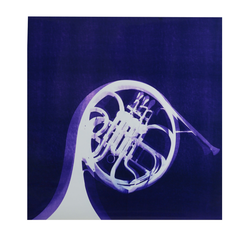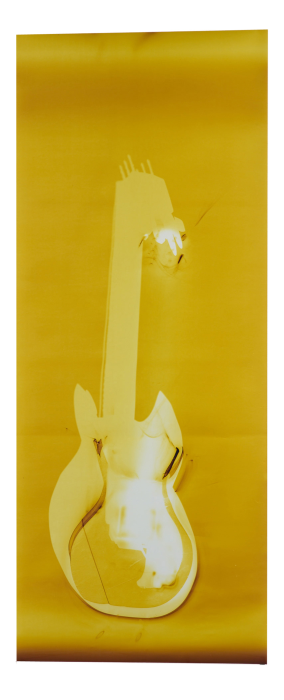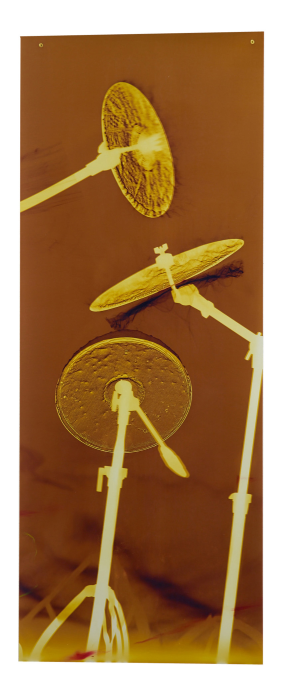 Homophony II
Homophony II
Farrah Karapetian, whose work was shown at Miami Project by Von Lintel Gallery (Los Angeles)
during Miami’s Art Week, is a creator of photograms, camera-less
photographs. She took time to answer some questions about her work in
general and Miami’s Art week.
The artist lives in Los Angeles and has recently had work shown at the Torrance Art Museum, the Armory Center for the Arts in Pasadena, the UCR/California Museum of Photography, the Vincent Price Museum and the Orange County Museum of Art.
In addition to her work being shown in Miami, she has an upcoming solo exhibition at Von Lintel. Find out and see more HERE.
The artist lives in Los Angeles and has recently had work shown at the Torrance Art Museum, the Armory Center for the Arts in Pasadena, the UCR/California Museum of Photography, the Vincent Price Museum and the Orange County Museum of Art.
In addition to her work being shown in Miami, she has an upcoming solo exhibition at Von Lintel. Find out and see more HERE.
Your
work seems to be both high concept and require extensive detailed
attention regarding technique as well. To you, as the artist, what is
most important--the concept or the visual, the aesthetic? I ask because,
looking at the pieces (out of context) they seem beautiful with no
explanation.
Thank you. I think, as in all introductions, human or otherwise, when we meet an artwork, we can find it beautiful and leave it at that, or we can find that we want more from it. Then we look longer and find out more about it... We ask questions about the elements that appear most mysterious and about which we are impatient to know more, but for the most part, all the clues are in the work.
There is no separation between the concept and the aesthetic in a good artwork: they create one another. The idea one has informs the way a piece is made, which informs the way it looks, and the strongest work surprises even the artist insofar as the results are not exclusively what one has planned.
My techniques are very simple. They shift depending upon the subject and depending upon what I've learned from observing a piece or body of work I've completed in the past, but all of those shifts are visible in the work: if you look long enough, you'll see where the paper has been touched, where glass might have refracted light, where two shadows suggest different moments of time captured in the image, where the fiction of a reenactment reveals itself.
What's important to me is that the right person develop a relationship with the piece - not at all only in terms of then buying the piece, but in terms of a student imagining themselves into the process and thinking about how it affects his or her notion of photography, a novelist catching the metaphor or grammar of an artwork and thinking about his or her own process, or anyone registering any kind of analogy with the work. It doesn't matter what part of my work burrows into the mind of an observer, as long as it does, and then opens for him or her new lines of questioning. One wants to be part of the conversation in other people's heads.
For the non photographer, non-artists, can you describe the process you use to create your pieces?
My work tends to consist of photograms and related sculptures. To make a photogram, one puts a subject in between a light source and a piece of photo-sensitive paper, then exposes the paper with the light and processes the paper in chemistry, resulting in a photographic print of the shadow of the subject.
So, if you walked into my darkroom to be the subject of a print, I would ask you to stand near the wall; I would point my photographic enlarger at you; I would turn off the overhead lights and turn on the enlarger; and we would look at your shadow together. If you and I had discussed at some point an object or an item of clothing necessary to the memory we were about to reenact, I would have remade it in a transparent material and I would have given it to you now to hold or handle. We would talk about the scene you were here to reenact for me, and I would ask you to use your muscle memory to be able to access the appropriate posture to create the shadow we both respond most to once I begin to expose the print. Then, I would turn off the lights and we would be in complete darkness. I would spend about 15 minutes cutting paper and another 15 getting it up on the wall - all in the dark. Then I would make my way back to my enlarger, you would resume the posture we had discussed, and I would begin the exposure, which is generally under 15 seconds. The room would go dark again; I would roll up my paper and put it in a tube; I would go process this paper in chemistry; and I would return to you so that you and I could discuss the palette of the resulting photogram.
Of course this process changes depending upon circumstance and the process behind making the sculptures and other kinds of photograms is fairly diverse, but that's a description of what has typically gone on in a shoot involving a subject with a memory that interested me.
Thank you. I think, as in all introductions, human or otherwise, when we meet an artwork, we can find it beautiful and leave it at that, or we can find that we want more from it. Then we look longer and find out more about it... We ask questions about the elements that appear most mysterious and about which we are impatient to know more, but for the most part, all the clues are in the work.
There is no separation between the concept and the aesthetic in a good artwork: they create one another. The idea one has informs the way a piece is made, which informs the way it looks, and the strongest work surprises even the artist insofar as the results are not exclusively what one has planned.
My techniques are very simple. They shift depending upon the subject and depending upon what I've learned from observing a piece or body of work I've completed in the past, but all of those shifts are visible in the work: if you look long enough, you'll see where the paper has been touched, where glass might have refracted light, where two shadows suggest different moments of time captured in the image, where the fiction of a reenactment reveals itself.
What's important to me is that the right person develop a relationship with the piece - not at all only in terms of then buying the piece, but in terms of a student imagining themselves into the process and thinking about how it affects his or her notion of photography, a novelist catching the metaphor or grammar of an artwork and thinking about his or her own process, or anyone registering any kind of analogy with the work. It doesn't matter what part of my work burrows into the mind of an observer, as long as it does, and then opens for him or her new lines of questioning. One wants to be part of the conversation in other people's heads.
For the non photographer, non-artists, can you describe the process you use to create your pieces?
My work tends to consist of photograms and related sculptures. To make a photogram, one puts a subject in between a light source and a piece of photo-sensitive paper, then exposes the paper with the light and processes the paper in chemistry, resulting in a photographic print of the shadow of the subject.
So, if you walked into my darkroom to be the subject of a print, I would ask you to stand near the wall; I would point my photographic enlarger at you; I would turn off the overhead lights and turn on the enlarger; and we would look at your shadow together. If you and I had discussed at some point an object or an item of clothing necessary to the memory we were about to reenact, I would have remade it in a transparent material and I would have given it to you now to hold or handle. We would talk about the scene you were here to reenact for me, and I would ask you to use your muscle memory to be able to access the appropriate posture to create the shadow we both respond most to once I begin to expose the print. Then, I would turn off the lights and we would be in complete darkness. I would spend about 15 minutes cutting paper and another 15 getting it up on the wall - all in the dark. Then I would make my way back to my enlarger, you would resume the posture we had discussed, and I would begin the exposure, which is generally under 15 seconds. The room would go dark again; I would roll up my paper and put it in a tube; I would go process this paper in chemistry; and I would return to you so that you and I could discuss the palette of the resulting photogram.
Of course this process changes depending upon circumstance and the process behind making the sculptures and other kinds of photograms is fairly diverse, but that's a description of what has typically gone on in a shoot involving a subject with a memory that interested me.
How does inspiration usually strike you in your work? You used past events, memories but what, to you makes a specific event or memory significant enough to create something out of it?
Much of the work of art is in paying close observation to oneself, what one has just done, what comes up next, and how it relates to something that has come before. In short, one has to be hyper-attentive to the threads of one's experience and observations; at the same time as one lives fully, one must reflect on one's life fully. It's a habit I'm sure shared across all professions wherein one must process the past, present, and future at once, but certainly shared across the disciplines of art and writing.
This makes me think of George Orwell's essay, "Why I Write," wherein he describes his habit of narrating his existence: "For minutes at a time this kind of thing would be running through my head: ‘He pushed the door open and entered the room. A yellow beam of sunlight, filtering through the muslin curtains, slanted on to the table, where a match-box, half-open, lay beside the inkpot. With his right hand in his pocket he moved across to the window. Down in the street a tortoiseshell cat was chasing a dead leaf’, etc. etc." In other words, he sees himself in the abstract as he participates in his life, and this became the stuff of later writing.
I mention all this because I think the word "inspiration" can be misleading. It implies that something inspiring happens in isolation, whereas in fact I think an experience or observation or a chance event feels inspiring because the way it connects to my life and/or work is surprising and feels true. If that feeling lasts for any length of time, I will pursue it, and begin to work with it until indeed it has resulted in something else surprising and true. If that doesn't happen, I put it away. Sometimes it rears its head again years later, as a part of a thread whose time has come.
What do you hope people take away from your work (aside, obviously, from purchasing it!)?
A physical registry of experience; a sense of surprise; a lasting image; a new question; a new desire.
You have a BA and an MFA; what was your BA in? I am curious how you moved from a BA (as opposed to BFA) to an MFA.
Well, at Yale, where I got my BA, the art major is a BA rather than a BFA. So, yes, I majored in fine art and concentrated in photography as an undergrad, but the art major is integrated there into the liberal arts curriculum. I actually think this is a great model, because after undergrad art is always integrated into the larger world and its variety of perspectives. Sometimes micro-cultures like the art world can become too insular. I took six years between my BA and MFA, though, during which time I really tested my practice and developed it to a point at which I needed grad school: I had questions that needed to be played out in an interdisciplinary arena unlike the more medium-specific context of undergrad, and UCLA's grad program was the right fit for that.
Have you shown work in Miami before? What do you feel showing does for you as an artist? How do you think this ever expanding week of art help (or not help...) artists? What is good and bad about the week overall?
No, I haven't shown in Miami before, nor been there, and I'm excited to visit Miami as well as exhibit with Von Lintel Gallery there this year. I want to see how the coastline differs from others I've known. Art fairs can be overwhelming for me, visually and experientially; there are so many dynamics between artworks and so many dynamics between people. When I go to a fair - or in this case, 20 fairs, numerous museums, and the NY Times Luxury Conference - I always need to rent an apartment so as to start the day quietly and alone. There's no need to see everything, anyway; the upside of that much art in one place at one time is that it is an opportunity to see work one might not see otherwise, in person rather than as a jpeg. (Jpegs lie.) I want to be surprised by what I see and learn from it. That's what seeing, making, and exhibiting artwork is 100% about.
Read original post @ Mapanare




No comments:
Post a Comment